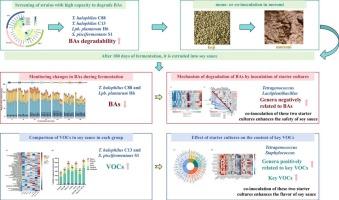与土产四红球菌共发酵提高酱油品质:减少生物胺,增强风味
IF 8
1区 农林科学
Q1 FOOD SCIENCE & TECHNOLOGY
引用次数: 0
摘要
酱油是起源于亚洲的一种传统的大豆发酵调味品,现已享誉世界。随着它的普及,确保它的安全和高质量变得越来越重要。在工业生产中,发酵剂对于控制微生物群落和提高产品的安全性和质量至关重要。本研究首先筛选了具有降解生物胺(BAs)能力的细菌发酵剂,然后将其单独或共同接种于酱油发酵中。结果表明,单次接种嗜盐四葡萄球菌C88、嗜盐四葡萄球菌C13、植物乳杆菌H6和鱼生葡萄球菌S1后,ba水平分别降低28.13%、29.55%、18.90%和14.63%。同时,这些处理使总挥发性有机物(VOCs)分别增加了28.00%、82.68%、46.67%和80.13%。值得注意的是,嗜盐乳杆菌C88与Lpb共接种。plantarum H6对BA的降解效果较好,降低了31.39%,而同时接种嗜盐T. halophilus C13和S. piscifermentans S1对VOCs的降解效果较单接种显著,比自然发酵提高了105.07%。综上所述,共发酵发酵剂之间的协同作用可以改善酱油品质。此外,该研究强调了使用互补发酵剂影响关键挥发性有机化合物代谢途径的潜力,为提高工业生产中酱油的安全性和风味特征提供了有价值的见解。本文章由计算机程序翻译,如有差异,请以英文原文为准。

Improving soy sauce quality via co-fermentation with indigenous Tetragenococcus: Reducing biogenic amines and enhancing flavor
Soy sauce, a traditional fermented soybean condiment originating in Asia, is now enjoyed worldwide. As its popularity grows, ensuring both its safety and high quality has become increasingly important. In industrial production, starter cultures are essential for controlling microbial communities and enhancing the safety and quality of the product. This study initially screened bacterial starter cultures with the ability to degrade biogenic amines (BAs), followed by their mono- or co-inoculation in soy sauce fermentation. The results showed that mono-inoculation with Tetragenococcus halophilus C88, Tetragenococcus halophilus C13, Lactiplantibacillus plantarum H6 and Staphylococcus piscifermentans S1 reduced BAs levels by 28.13 %, 29.55 %, 18.90 % and 14.63 % respectively. Concurrently, these treatments increased the total volatile organic compounds (VOCs) by 28.00 %, 82.68 %, 46.67 % and 80.13 % respectively. Notably, co-inoculation of T. halophilus C88 with Lpb. plantarum H6 led to superior BA degradation decreased by 31.39 %, while co-inoculating T. halophilus C13 and S. piscifermentans S1 resulted in a greater increase in VOCs compared to mono-inoculation, achieving a 105.07 % rise compared to natural fermentation. These findings indicate that synergistic interactions between co-fermentation starters can improve soy sauce quality. Additionally, the research highlights the potential of using complementary starter cultures to influence the metabolic pathways of key VOCs, offering valuable insights for enhancing both the safety and flavor profiles of soy sauce in industrial production.
求助全文
通过发布文献求助,成功后即可免费获取论文全文。
去求助
来源期刊

Food Research International
工程技术-食品科技
CiteScore
12.50
自引率
7.40%
发文量
1183
审稿时长
79 days
期刊介绍:
Food Research International serves as a rapid dissemination platform for significant and impactful research in food science, technology, engineering, and nutrition. The journal focuses on publishing novel, high-quality, and high-impact review papers, original research papers, and letters to the editors across various disciplines in the science and technology of food. Additionally, it follows a policy of publishing special issues on topical and emergent subjects in food research or related areas. Selected, peer-reviewed papers from scientific meetings, workshops, and conferences on the science, technology, and engineering of foods are also featured in special issues.
 求助内容:
求助内容: 应助结果提醒方式:
应助结果提醒方式:


